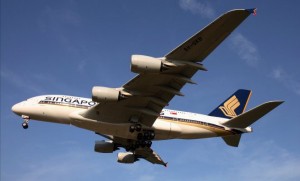
As the world’s economy began to improve modestly towards the end of 2012, trends in the global airline industry were emerging that gave clear indications of what can be expected in 2013 – all things being equal. Of course, they rarely are equal in the airline industry, but as figures released by the Centre for Aviation show, what is clear from the last 12 months is that the strong get stronger and the weak consider their options.
Airlines
The merger of Continental and United has, as expected, created the world’s largest airline. By ranking of capacity, coming in at number one at the end of 2012 was United, followed by another airline having concluded consolidation – Delta.
The world’s third largest airline – Emirates – grew capacity by 18.4 per cent and is the only non-US airline in the top five. Fourth and fifth positions are occupied by American Airlines and Southwest respectively.
Australian airlines faced mixed fortunes. Qantas recoiled 5.3 per cent and dropped two places in the capacity rankings from 14th to now 16th. Jetstar, conversely, grew by 16.7 per cent to rise four places to 42nd, one place ahead of Air New Zealand. Virgin Australia joined the top 50 airlines, having recorded 18.3 per cent growth during 2012 to come in at 49th.
In other regions some interesting trends emerged during the year. Of particular interest was the rise of Chinese carriers and the faltering of the Indian market, the latter a complete contrast to previous years of rampant growth.
China Southern is China’s largest airline by capacity offered, growing by 11 per cent and coming in at ninth position, the airline’s second year in the top 10. Air China also enjoyed 11 per cent growth in 2012, seeing it climb to become the world’s 12th largest carrier, while China Eastern grew by 10.2 per cent to rise one position to 14th.
Other airlines in rapid ascendance were Turkish Airlines (+24 per cent), Qatar Airways (+8.7 per cent), ANA (+24.3 per cent), Aeroflot (+15.9 per cent), Etihad (+14.8 per cent) and low cost carrier Lion Airlines (+34.6 per cent).
Indian airlines, however, reversed previous years’ gains. Gol and Jet Airways receded 9.3 and 11 per cent respectively, the latter dropping seven places to 46th. Air India reduced capacity by 3.2 per cent.
Other airlines on a rapid descent during 2012 were Cathay Pacific (-8.2 per cent), Iberia (-12.7 per cent) and Ryanair (-7.2 per cent).
Low cost airlines have a 22.3 per cent share of the global market, down very marginally on the previous years’ share.
More than 50 airlines ceased operating or were merged during 2012, including some big names such as bmi in the UK; Malev and Spanair in Europe while locally Air Australia and Norfolk Air disappeared from the flight boards.
Alliances
As membership of airline alliances continues to grow, the first real signs emerged during the year that bilateral arrangements between airlines are becoming more meaningful to revenue than the marketing benefits offered by branded global alliances.
While the figures for the three global alliances possibly belie the growing relevance of bilaterals – oneworld up 3.5 per cent, STAR up 6.3 per cent and SkyTeam up 10.2 per cent – it is what was happening outside the alliance groupings that was most telling.
The creation of a partnership between Emirates and Qantas was the clearest local indication that some steam may be coming out of oneworld’s global leverage, something that may be tested further during 2013 as Emirates seeks to court American Airlines in an expansion of its arrangements with Qantas to create a true round-the-world product.
Etihad also remains staunchly outside a global alliance, but works with airlines that are members of alliance groupings either under bilateral agreements or equity arrangements such as with Virgin Australia and airberlin. Etihad’s capacity growth of nearly 15 per cent has come from the success of those bilateral partnerships as much as it has from organic growth, something the Middle East carriers have been supreme at achieving in recent years.
Qatar Airways has bucked the cherished independence of Middle East carriers, though, to join the ranks of oneworld.
Airports
Reflecting the continued strong growth of its airlines, China’s Beijing now is the world’s second busiest airport when ranked by the number of available seats. While the world’s number one airport remains Atlanta, just 10,000 seats a week separate it from Beijing. Trends indicate Atlanta will be toppled decisively during 2013.
Third, fourth and fifth positions are occupied by Tokyo (Haneda), Heathrow and Dubai respectively, with Dubai expected to take fourth position during the coming year.
Sydney ranked 26th in the world, ahead of Amsterdam and below San Francisco, while Melbourne took 44th position just ahead of Shenzhen and Munich.
Note – Airline rankings in this article are by available seat kilometres (ASKs), a measure of capacity offered. ASKs do not measure revenue passenger traffic or company financial results, both measures that may cause airlines to be ranked differently.










